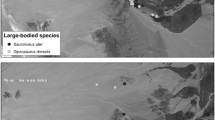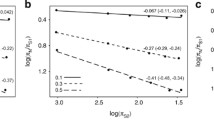Abstract
The genetic structure of nine Peromyscus maniculatus nebrascensis demes from southeastern Wyoming was determined by analyzing allozymes encoded by 23 genetic loci with polyacrylamide gel electrophoresis. Genetic variability is extremely high for two genetic parameters; the proportion of loci heterozygous per individual averaged 0.16, and the proportion of loci polymorphic per deme averaged 0.41. Previous estimates of genetic heterozygosity for species within the genus Peromyscus have a mean of 0.06. The results of the present study suggest that genetic heterozygosity is considerably higher within P. maniculatus demes than within demes of other species in the genus. Geographic range is correlated with heterozygosity among Peromyscus species, as is adaptive divergence into broad-niched species. These correlates suggest that high heterozygosity may reflect an adaptation to a variable environment.
Similar content being viewed by others
References
Ahl, A. (1967). Distribution of blood proteins of three altitudinal groups of Peromyscus maniculatus nebrascensis. Unpublished Ph.D. thesis, University of Wyoming.
Ahl, A. S. (1968). Electrophoretic examination of hemoglobin and plasma proteins from three altitude groups of Peromyscus maniculatus nebrascensis. Comp. Biochem. Physiol. 24427.
Avise, J. C., Smith, M. H. and Selander, R. K. (1974a). Biochemical polymorphism and systematics in the genus Peromyscus. VI. The boylii species group. J. Mammal. 55751.
Avise, J. C., Smith, M. H., Selander, R. K., Lawlor, T. E., and Ramsey, P. R. (1974b). Biochemical polymorphism and systematics in the genus Peromyscus. V. Insular and mainland species of the subgenus Haplomylomys. Syst. Zool. 23226.
Baker, R. H. (1968). Habitats and distributions. In King, J.A. (ed.), Biology of Peromyscus, Special Publication No. 2, The American Society of Mammalogists, p. 98.
Burt, W.H. (1961). Some effects of volcano Paricutin on vertebrates. Occ. Papers Mus. Zool. Univ. Mich. 6201.
Davis, B. J. (1964). Disc electrophoresis. II. Methods and application to human serum proteins. Ann. N.Y. Acad. Sci. 121404.
Davis, P. R. (1976). Response of vertebrate fauna to forest fire and clearcutting in south central Wyoming. Unpubl. Ph.D. thesis, University of Wyoming.
Echelle, A. A., Echelle, A. F. and Taber, B. A. (1976). Biochemical evidence for congeneric competition as a factor restricting gene flow between populations of a darter (Percidae: Etheostoma). Syst. Zool. 25228.
Gill, A. E. (1976). Genetic divergence of insular populations of deer mice. Biochem. Genet. 14835.
Hall, E. R., and Kelson, K. R. (1959). The Mammals of North America, Vol. 2. Ronald Press, New York.
Hooper, E. T. (1968). Classification. In King, J.A. (ed.), Biology of Peromyscus, Special Publication No. 2, The American Society of Mammalogists, p. 27.
Inger, R. F., Voris, H. K., and Voris, H. H. (1974). Genetic variation and population ecology of some southeast Asian frogs of the genera Bufo and Rana. Biochem. Genet. 12121.
Johnson, G. L., and Packard, R. L. (1974). Electrophoretic analysis of Peromyscus comanche (Blair), with comments on its systematic status. Occ. Papers Mus. Tex. Tech. Univ. 241.
Johnson, W. E., and Selander, R. K. (1971). Protein variation and systematics in kangaroo rats (genus Dipodomys). Syst. Zool. 20377.
Kilpatrick, C. W., and Zimmerman, E. G. (1975). Genetic variation and systematics of four species of mice of the Peromyscus boylii species group. Syst. Zool. 24143.
Kilpatrick, C. W., and Zimmerman, E. G. (1976). Biochemical variation and systematics of Peromyscus pectoralis. J. Mammal. 57506.
Levins, R. (1968). Evolution in Changing Environments Princeton University Press, Princeton, N.J.
Lewontin, R. C. (1974). The Genetic Basis of Evolutionary Change Columbia University Press, New York.
McGee, J. M. (1976). Some effects of fire suppression and prescribed burning on birds and small mammals in sagebrush. Unpublished Ph.D. thesis, University of Wyoming.
Nei, M. (1972). Genetic distance between populations. Am. Nat. 106283.
Nei, M. (1975). Molecular Population Genetics and Evolution North-Holland, Amsterdam.
Nevo, E. (1976). Adaptive strategies of genetic systems in constant and varying environments. In Karlin, S., and Nevo, E. (eds.), Population Genetics and Ecology Academic Press, New York, p. 141.
Rasmussen, D. I. (1970). Biochemical polymorphisms and genetic structure in populations of Peromyscus. Symp. Zoo. Soc. London 26335.
Selander, R. K. (1976). Genic variation in natural populations. In Ayala, F. J. (ed.), Molecular Evolution Sinauer Associates, Sunderland, Mass., p. 21.
Selander, R. K., and Johnson, W. E. (1973). Genetic variation among vertebrate species. Ann. Rev. Ecol. Syst. 475.
Selander, R. K., and Kaufman, D. W. (1973). Genic variability and strategies of adaptation. Proc. Natl. Acad. Sci. 701875.
Selander, R. K., Smith, M. H., Yang, S. Y., Johnson, W. E., and Gentry, J. B. (1971). Biochemical polymorphism and systematics in the genus Peromyscus. I. Variation in the old-field mouse (Peromyscus polionatus). Stud. Genet. VI: Univ. Texas Publ. 710349.
Shaw, C., and Prasad, R. (1970). Starch gel electrophoresis of proteins—A compilation of recipes. Biochem. Genet. 4297.
Smith, M. H., Selander, R. K., and Johnson, W. E. (1973). Biochemical polymorphism and systematics in the genus Peromyscus. III. Variation in the Florida deer mouse (Peromyscus floridanus), a Pleistocene relict. Jr. Mammal. 541.
Smith, M. H., Garten, C. T., and Ramsey, P. R. (1975). Genic heterozygosity and population dynamics in small mammals. In Markert, C. (ed)., Isozyme IV: Genetics and Evolution Academic Press, New York, p. 85.
Soulé, M. (1971). The variation problem: The gene flow variation hypothesis. Taxon 2037.
Soulé, M. (1976). Allozyme variation: Its determinants in space and time. In Ayala, F. J. (ed.), Molecular Evolution Sinauer Associates, Sunderland, Mass., p. 60.
Author information
Authors and Affiliations
Additional information
This study was supported by funds from Public Health Service Grant GM-20491, National Institutes of Health, from The University of Wyoming Division of Basic Research, and from The Rocky Mountain Parks Cooperative Study Program.
Rights and permissions
About this article
Cite this article
Loudenslager, E.J. Variation in the genetic structure of Peromyscus populations. I. Genetic heterozygosity—its relationship to adaptive divergence. Biochem Genet 16, 1165–1179 (1978). https://doi.org/10.1007/BF00484537
Received:
Revised:
Issue Date:
DOI: https://doi.org/10.1007/BF00484537




